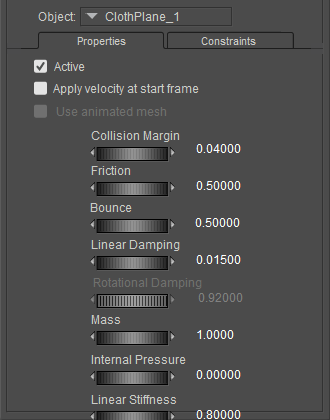Setting Object Properties
The Properties tab in the Physics palette allows you to assign properties to each of the physics objects in your scene. The properties that are available depend on the type of object you are configuring.

Setting Object Properties.
Select the object that you want to configure from the Object menu, and then click the Properties tab to display the following options:
If your scene includes several objects that need to share the same physics properties (for example, ten bowling pins), create the first object and set its physics properties. Then use the Edit > Duplicate Object command to duplicate the first object and its physics properties. The duplicated object will automatically be added to the current simulation. Alternatively, you can save the first object to the Library with its physics properties, and then add it from the Library to the current simulation.

You can duplicate objects to add a new object with the same physics settings.
- Active: Check this option to apply the physics simulation calculations to the currently selected object. You can uncheck the option to remove the object from the calculations without affecting the other settings that are applied to it.
- Apply Velocity from First Frame: If an object is animated up to the starting frame of a physics simulation, check this option to set the initial velocity of the object to be the same when the simulation starts. For example, if you want a bowling ball to move at a certain speed and direction, move the frame before you want the physics to take over. Advance to the next frame and move the ball to reflect the speed and direction that you want the ball to move. This will set the base velocity which will be taken into account when the simulation is calculated.
- Use Animated Mesh: When this option is checked, a new collision geometry will be created at every frame for the selected choreographed object, to support morphs, bending, magnets, etc. It generates a convex hull for each frame from the bent parts.
If you want the physics to take over at a frame other than 1, make sure that you set the appropriate start frame in the Physics Palette, as described in Creating a Simulation.
- Collision Margin: Defines the amount of distance that will be allowed between physics objects and the objects they collide with. Penetration can occur if the margin is set too low.
The Collision Margin setting is related to your preferred units. which are set in the Interface tab of the General Preferences dialog, described in Interface Preferences.
- Friction: Lower friction amounts cause objects to move more easily over other objects. A value of 1 will make the object very sticky, and a value of 0 will make the object more slippery.
- Bounce: Low values make the object less bouncy; higher values make the object more bouncy. When bounce is set to 0, the object will not bounce. A value of 1 makes the object bounce indefinitely.
- Linear Damping: (Hard and Soft Body objects only). The amount of energy that is lost during each iteration when an object moves linearly (such as from side to side). Without damping, the object will appear to vibrate in the scene. A value of 1 will absorb shock. A value of zero will remove damping from the object.
- Rotational Damping: (Hard Body objects only). Similar to linear damping, except that this setting controls the amount of energy that is lost during each iteration when an object is rotating or spinning.
- Mass: (Hard and Soft Body objects only). A relative measurement that affects how objects of a higher mass interact with objects of a lower mass. Items with a lower mass setting will accelerate more after a collision than items of a larger mass. Stronger forces will be needed to move objects that have a higher mass. When objects with a higher mass interact with objects of a lower mass, the objects of lower mass will move more easily. Using the example of a bowling ball and pins, the mass of the bowling ball (example: 16 units) should be set higher than that of the pins (example: 2 units) in order for the pins to react appropriately when the ball strikes them.
- Internal Pressure: (Soft Body objects only). Specifies the internal pressure of the object. Objects that have a greater internal pressure will collapse upon themselves less than objects that have a smaller amount of internal pressure.
- Linear Stiffness: (Soft Body objects only). Lower the linear stiffness to make the object more stretchy; increase the value to make it more stiff.
Choose Edit > Memorize > All after all of the objects in your scene are set up. This allows you to go return to the original placement of your objects after you experiment with settings during live simulation.